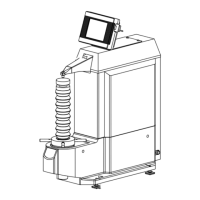No. 99MBG518A
A-12
PART A : 4 Hardness Test Methods
4.2
Brinell Hardness Test
4.2.1 About the Brinell Hardness Test
The Brinell hardness is calculated from the test force applied to make a circular indent on the test sur-
face using a carbide ball indenter and from the surface area of the indent. This test is used for testing
large specimens that have coarse particle surfaces in uneven quality, such as castings or forgings.
■Indent of the Brinell hardness test
F
d
1
d
2
h
Indent of the Brinell hardness test
Brinell hardness calculation method
k
HBW
=
S
0.102
22
π
=
D
-
-
HBW:
Brinell hardness value
D:
Diameter of indenter [mm]
F:
Test force [N]
d:
Mean diameter of indent [mm], d = (d
1
+d
2
) / 2
S:
Indent surface area [mm
2
]
k:
Constant=0.102≈
1
9.80665
4.2.2 Precautions for the Brinell Hardness Test
■Test surface
Thetestsurfaceshouldbeaatsurfaceatarightangletothedirectionofthetestforce.
Forthenishofthetestsurface,performthefollowing:
y To read the diameter of the indent up to 0.05 mm:
Finishbymachiningthatcanmakeasmoothnish,ling,orgrinding.
y To read the diameter of the indent up to 0.01 mm:
Finishusingnegrainsandpaper.

